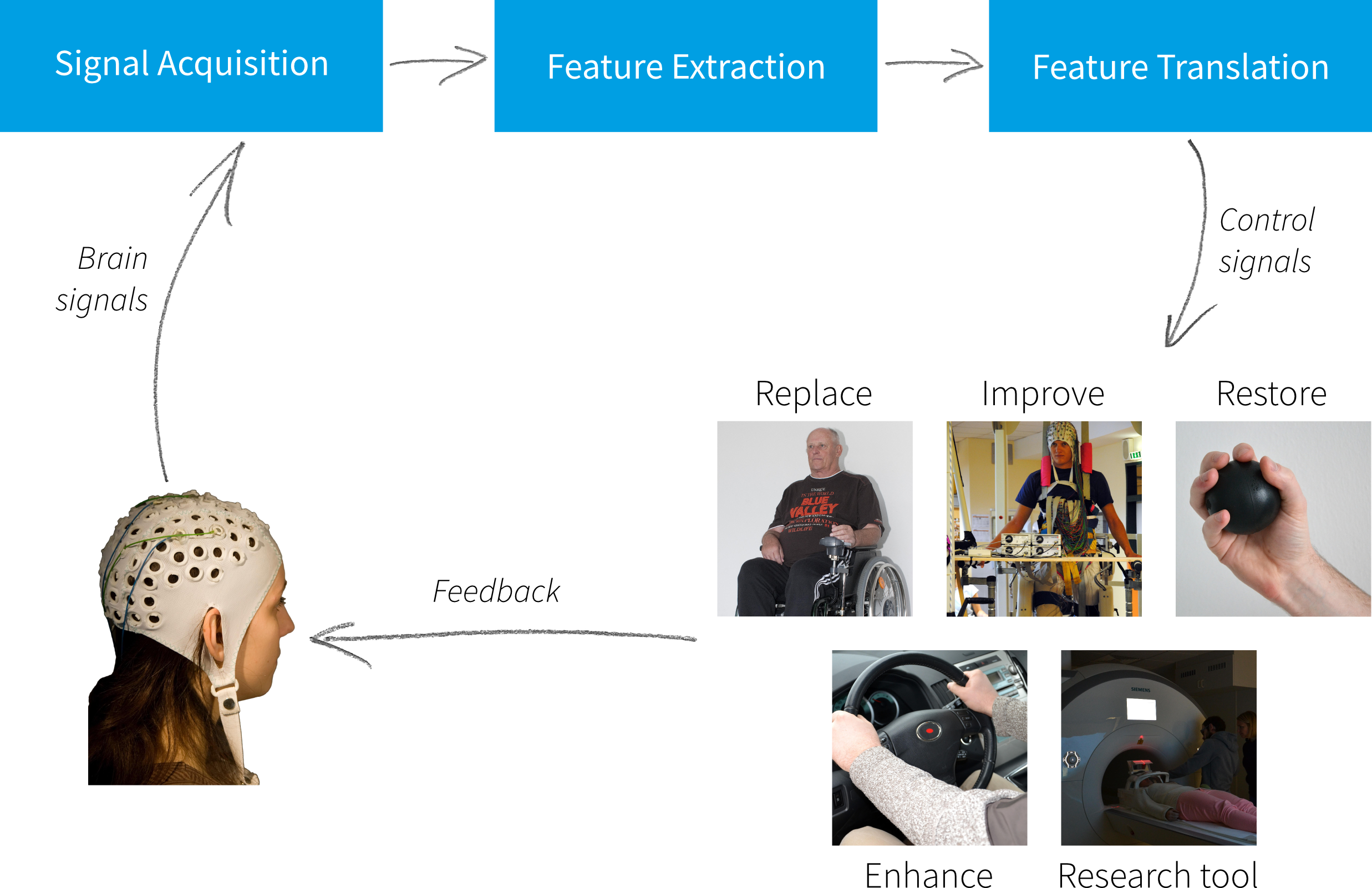Basics
A brain-computer interface (BCI) is a device that enables communication without movement [1]. People can communicate via thought alone. Since BCIs do not require movement, they may be the only communication system possible for severely disabled users who cannot speak or use keyboards, mice, or other interfaces.
Most BCI research focuses on helping severely disabled users send messages or commands. However, this is beginning to change. Some companies have begun offering BCI-based games for healthy users, and other groups are developing or discussing BCIs for new purposes and for new users.
There are often a lot of misunderstandings about what BCIs can and cannot do. BCIs do not write to the brain. BCIs do not alter perception or implant thoughts or images. BCIs cannot work from a distance, or without your knowledge. To use a BCI, you must have a sensor of some kind on your head, and you must voluntarily choose to perform certain mental tasks to accomplish goals.
In the most commonly adopted definition, any BCI must meet four criteria [2]. First, the device must rely on direct measures of brain activity. Second, the device must provide feedback to the user. Third, the device must operate online. Fourth, the device must rely on intentional control. That is, the users must choose to perform a mental task, with the goal of sending a message or command, each time they want to use the BCI.
A more recent definition describes a BCI as follows [3]: A BCI is a system that measures central nervous system (CNS) activity and converts it into artificial output that replaces, restores, enhances, supplements, or improves natural CNS output and thereby changes the ongoing interactions between the CNS and its external or internal environment.
This definition includes BCIs that do not require intentional control, which are sometimes referred to as passive BCIs [4]. A BNCI (brain/neuronal computer interaction) system extends a BCI by including other physiological measures such as muscle or eye movement signals. However, such systems are now more commonly referred to as hybrid BCIs or multimodal BCIs.

In more detail, BCIs can be used in the following six scenarios (see the Figure above, adapted from [3]):
- BCIs can replace natural CNS output that has been lost as a result of injury or disease. Examples include communication (through a spelling system and voice synthesis) and motorized wheelchair control.
- BCIs can restore lost natural CNS output. Examples include functional electrical stimulation of muscles in a paralyzed person and stimulation of peripheral nerves to restore bladder function.
- BCIs can enhance natural CNS output. Examples include monitoring brain activity during prolonged demanding tasks such as driving a car and detecting lapses of attention, which alerts the person and restores attention.
- BCIs can supplement natural CNS output. Examples include providing a third (robotic) arm to a person and providing a selection function for people using a joystick.
- BCIs can improve natural CNS output. Examples include using a BCI in stroke rehabilitation that detects and enhances signals from a damaged cortical area and stimulate arm muscles or an orthosis to improve arm movements.
- BCIs can be used as a research tool to investigate CNS functions in clinical and non-clinical research studies.
Our bibliography contains many review articles which provide newcomers with a detailed overview of the BCI research field.
References
[1] Wolpaw JR, Birbaumer N, McFarland DJ, Pfurtscheller G, Vaughan TM. Brain-computer interfaces for communication and control. Clin Neurophysiol, 113(6):767-791, 2002.
[2] Pfurtscheller G, Allison BZ, Brunner C, Bauernfeind G, Solis-Escalante T, Scherer R, Zander TO, Müller-Putz G, Neuper C, Birbaumer N. The hybrid BCI. Front Neurosci, 4:30, 2010.
[3] Wolpaw JR, Winter Wolpaw E. Brain-computer interfaces: something new under the sun. In: Wolpaw JR, Winter Wolpaw E. Brain-computer interfaces: principles and practice, pp. 3-12, Oxford University Press, New York, 2012.
[4] Zander TO, Kothe C. Towards passive brain-computer interfaces: applying brain-computer interface technology to human-machine systems in general. J Neural Eng, 8:025005, 2011.
